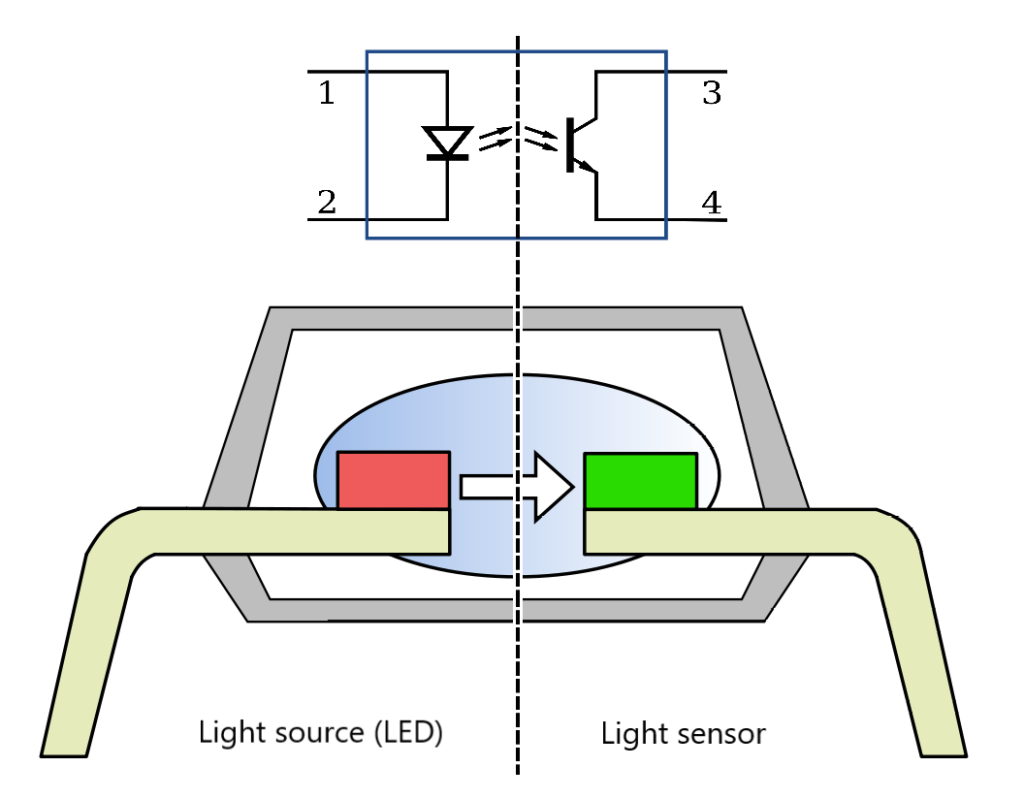What is a digital optical isolator?
Digital optical isolator (also called an optocoupler, photocoupler) is an electronic component that transfers electrical signals between two isolated circuits by using light which galvanically separates two sides of the electronic circuit. This gap distance between the two sides of the isolator defines the main specification of such electronic component – the isolation voltage which goes up to a range of 10kV and voltage transients with speeds up to 25 kV/μs. The main function of an opto-isolator is to block such high voltages and voltage transients, so that a surge in one part of the system will not disrupt or destroy the other parts. A digital optical isolator can transfer a data such as 1 and 0 (digital values), but of course there are also analog optical isolators but they are less common.

Simplified cross-section through a standard dual-in-line (DIL) package of the optical isolator – bottom.
How does a digital optical isolator work?
An opto-isolator contains a source (emitter) of light, light-emitting diode (LED), that converts electrical input signal into light, an optical channel (also called dielectrical channel), and a photosensor, which detects incoming light and either generates electric energy directly, or modulates electric current flowing from an external power supply. The sensor can be a photo-resistor, a photo-diode, a photo-transistor, a silicon-controlled rectifier (SCR) or a triac. Since LED can sense light in addition to emitting it, construction of symmetrical, bidirectional opto-isolators is possible. An opto-coupled solid-state relay contains a photo-diode opto-isolator which drives a power switch, usually a complementary pair of MOSFETs.
Where are digital optical isolators used?
Electronic equipment, signal and power transmission lines can be subjected to voltage surges induced by lightning, electrostatic discharge, radio frequency transmissions, switching pulses (spikes) and perturbations in power supply. Remote lightning strikes can induce surges up to 10 kV, one thousand times more than the voltage limits of many electronic components. A circuit can also incorporate high voltages by design, in which case it needs safe, reliable means of interfacing its high-voltage components with low-voltage ones. They are used in power supplies, computers, high voltage motor drivers, televisions, cars, etc. Also they exists in different form factors from small electronic components, to bigger industrial-grade devices.

PoOptoIn | 16 channel digital optical isolator
As mentioned, optical isolators are used to isolate two sides of electronic circuit in order to prevent damage because of high voltage spikes…. In PoLabs we also offer a few isolation devices and one is a PoOptoIn device which is used to protect a control unit, such as PoKeys57CNC from unwanted potentially high voltage spikes from the switches and other sensors which can have long cables thus inducted spikes can damage a control unit… PoOptoIn isolation device effectivelly isolate up to 16 inputs with LED indication. If it is used with PoKeys57CNC, it can be directly connected to Limit/Home connector.

Specifications
PoOptoIn isolation device effectively isolate up to 16 inputs with LED indication. If it is used with PoKeys57CNC, it can be directly connected to Limit/Home connector.
| Vin | 5-36V | Input voltage range. |
| Iin max. | 20mA | Maximum input current. |
| VDS max. | 40V | Maximum Drain-to-Source voltage. |
| IDS max. | 500mA | Maximum Drain-to-Source current. |
| Vindication_LED | 3-6V | Indication LEDs power supply voltage range. |
| Iindication_LED/LED | <5mA | Indication LED current. |
Wiring
More about
PoLabs web page.
Wiki about optocouplers.
The post Digital optical isolator | PoOptoIn 16 channel isolation device appeared first on PoBlog™.
